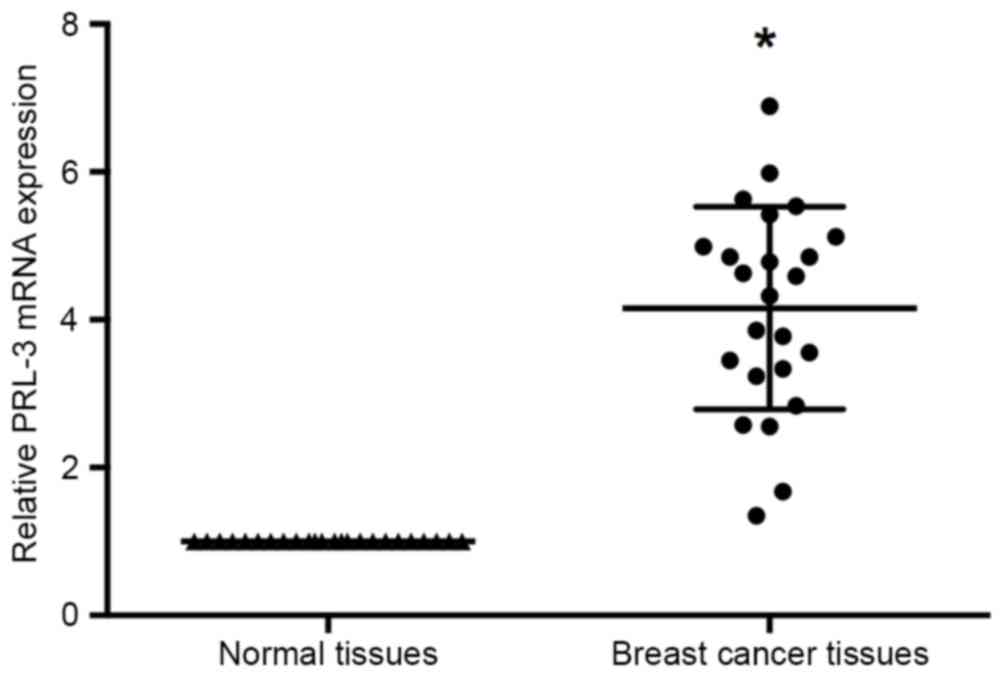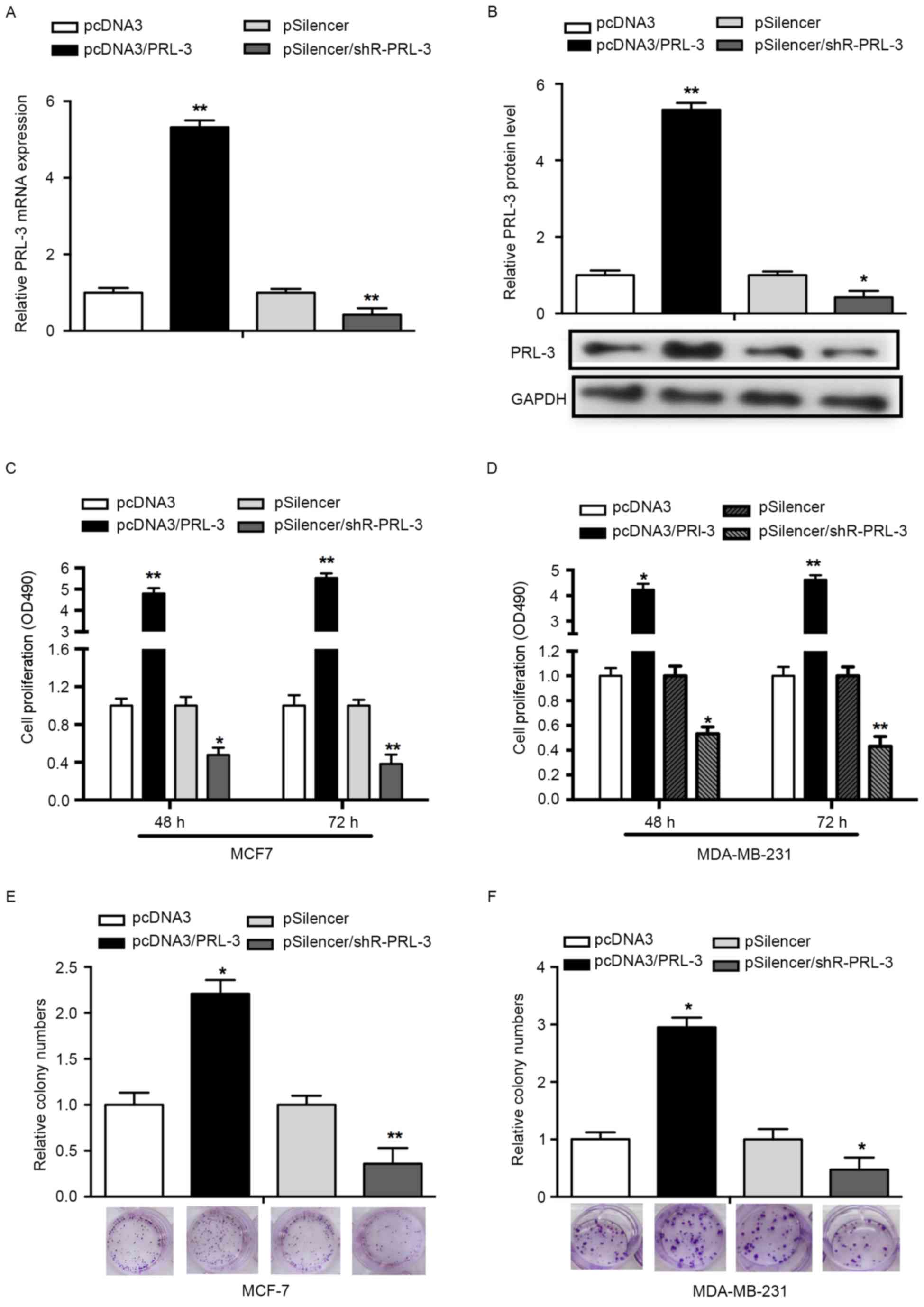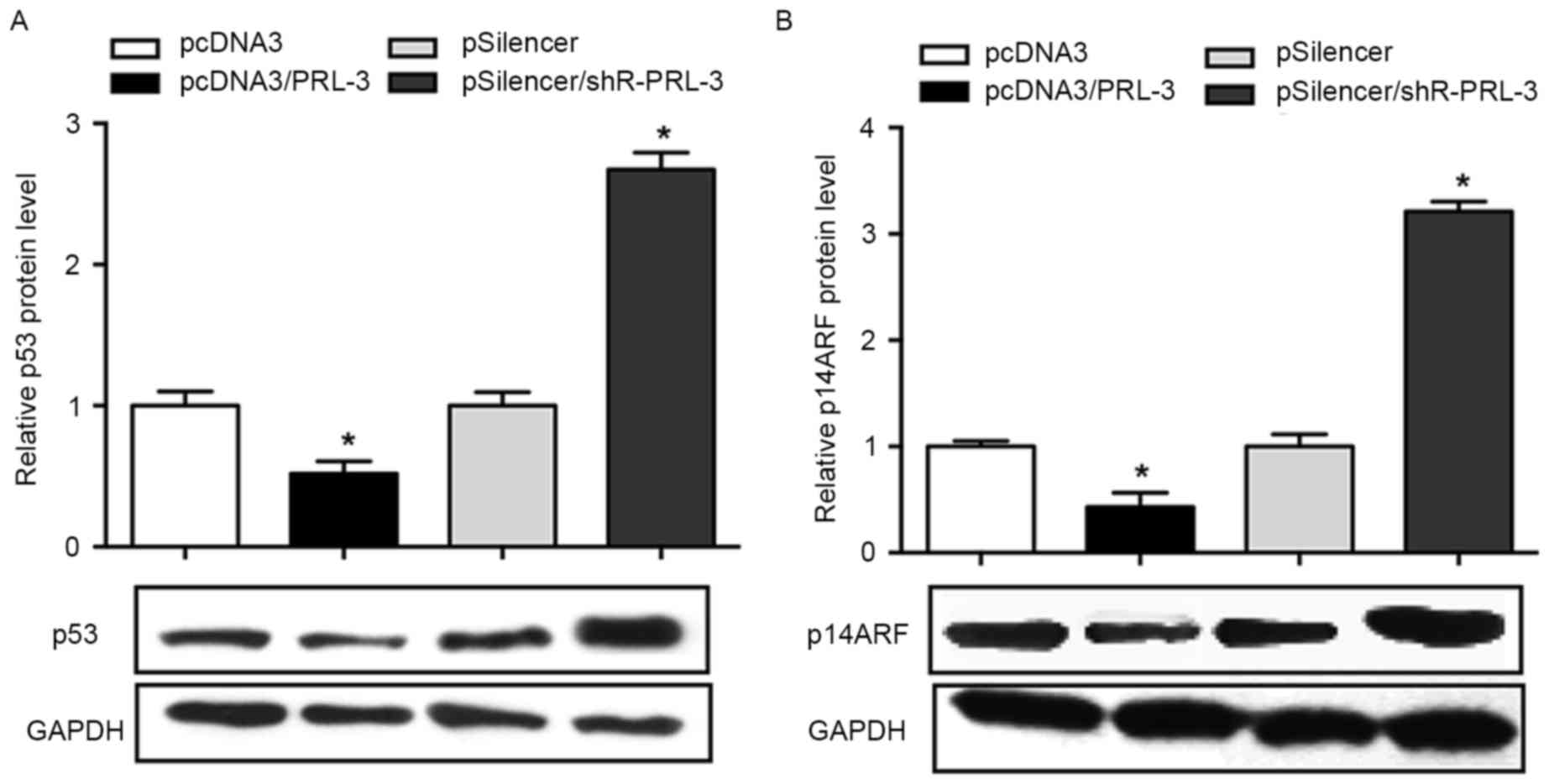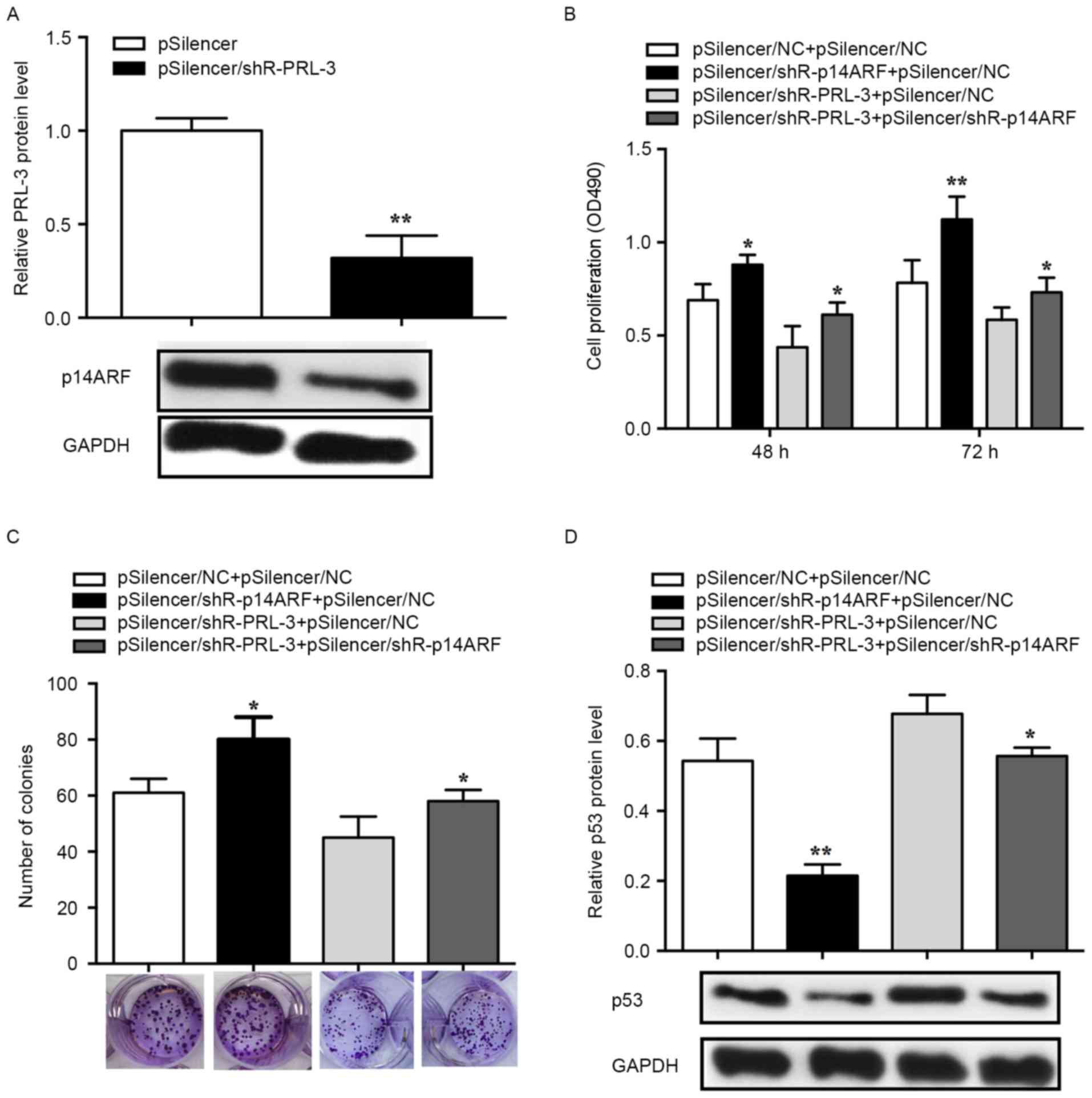PRL-3 promotes breast cancer progression by downregulating p14ARF-mediated p53 expression
- Authors:
- Published online on: December 19, 2017 https://doi.org/10.3892/ol.2017.7639
- Pages: 2795-2800
-
Copyright: © Xie et al. This is an open access article distributed under the terms of Creative Commons Attribution License.
Abstract
Introduction
Breast cancer is the most common type of invasive cancer in females worldwide (1). Despite diverse screening programs and novel therapeutic strategies implemented to markedly decrease mortality rates, the physiological mechanism underlying the pathogenesis of breast cancer remains unknown (2). Therefore, the identification of biomarkers is required to improve the early diagnosis of breast cancer and decrease cancer mortality rates.
Phosphatase of regenerating liver-3 (PRL-3), also known as PTP4A3, is a member of the protein tyrosine phosphatase superfamily (3). Protein tyrosine phosphatases exert crucial functions in modulating cellular processes, including cell growth, cell cycle progression and apoptosis, by regulating a number of proteins (4,5). PRL-3 is associated with tumor proliferation and metastasis, and is overexpressed in various types of cancer, including colorectal (6) and gastric cancer (7,8), ovarian carcinoma (9,10), multiple myeloma (11) and squamous cell carcinoma of the uterine cervix (12). Wang et al (13) demonstrated that PRL-3 was overexpressed in breast cancer and predicts a poor clinical outcome for patients. In the present study, PRL-3 was identified to function in tumor proliferation by acting on the p14ARF-p53 axis, suggesting that PRL-3 may be involved in the tumorigenesis of breast cancer.
Materials and methods
Tissues specimens and cell lines
A total of 24 breast cancer and adjacent normal tissues were obtained from the Sichuan Cancer Hospital (Chengdu, China). The tissues from each individual were frozen in liquid nitrogen and stored at −80°C until use. The tissues were fixed with 10% formalin overnight at room temperature and the fixed-tissues were embedded in paraffin. The 4-µm-thick sections of the tissues were validated using H&E staining and immunohistochemical detection. Briefly, sections were stained for nuclei with hematoxylin for 5 min at room temperature, and then sections were washed with tap water and counterstained with eosin for 1 min and washed. The following primary antibodies were used to perform immunohistochemistry: anti-estrogen receptor (cat. no. ab180900; dilution, 1:200; Abcam, Cambridge, UK), anti-progesterone receptor (cat. no. ab32085; dilution, 1:100; Abcam) and anti-HER2 (cat. no. ab194979; dilution, 1:200; Abcam). Briefly, sections were blocked using 2% PBS + bovine serum albumin for 15 min at room temperature. Subsequently, primary antibody incubation was performed overnight at 4°C. Next, a biotinylated anti-rabbit immunoglobulin (Ig)G (cat. no. ab150088; dilution, 1:2,000; Abcam) was used as a secondary antibody. The antibody staining in the tissue sections was observed using a light microscope (magnification, ×40). Written informed consent was obtained from all patients and all protocols were approved by the Sichuan Cancer Hospital Ethics Committee (Chengdu, China).
Two breast cancer cell lines (MDA-MB-231 and MCF-7) were purchased from the Chinese Academy of Sciences (Shanghai, China) and cultured in Dulbecco's modified Eagle's medium (Gibco; Thermo Fisher Scientific, Inc., Waltham, MA, USA), supplemented with 10% fetal bovine serum (HyClone; GE Healthcare Life Sciences, Logan, UT, USA) at 37°C in a humidified chamber containing 5% CO2.
RNA extraction and reverse transcription-quantitative polymerase chain reaction (RT-qPCR)
TRIzol® reagent (Invitrogen, Thermo Fisher Scientific, Inc.) was used to extract total RNA from the breast cancer tissues or two breast cancer cell lines (MDA-MB-231 and MCF-7) and subsequently reverse-transcribed into cDNA using a First Strand cDNA Synthesis kit (Roche Diagnostics GmbH, Mannheim, Germany) according to the manufacturer's protocol with the following temperature protocol: −25°C for 10 min and then at 42°C for 60 min, followed by 99°C for 5 min and then cooling to 4°C for 5 min. Subsequently, RT-qPCR was performed on the ABI 7500 Fast Real-Time PCR system (Applied Biosystems; Thermo Fisher Scientific, Inc.) with FastStart™ Universal SYBR® Green Master (ROX) reagents (Roche Diagnostics GmbH). The temperature protocols for the qPCRs were as follows: 95°C for 10 min, 40 cycles of 95°C for 30 sec (inactivation) and 56°C for 1 min (annealing). A melt curve was constructed following each reaction and data were analyzed using a 7500 Fast System SDS (version 1.4.0.25; Applied Biosystems; Thermo Fisher Scientific, Inc.). The primer sequences for PRL-3 were as follows: Forward, 5′-CTTCCTCATCACCCACAACC-3′; reverse, 5′-GTCTTGTGCGTGTGTGTGGGTC-3′. The primer sequences for p14ARF were as follows: Forward, 5′-GCCACATTCGCTAAGTGCTC-3′ and reverse, 5′-GCCACATTCGCTAAGTGCTC-3′. The primer sequences for GAPDH were as follows: Forward, 5′-AACGACCCCTTCATTGAC-3′ and reverse, 5′-TCCACGACATACTCAGCAC-3′. All reactions were conducted in triplicate. GAPDH was used as the normalization control and the relative levels were quantified using the 2−ΔΔCq method (14).
Plasmid construction and transfection
Total RNA was extracted from the MDA-MB-231 cells using TRIzol buffer (Invitrogen; Thermo Fisher Scientific, Inc.). Then the reverse transcription was performed using a Transcript First Strand cDNA Synthesis kit (Roche Diagnostics GmbH). The cDNA of PRL-3 was amplified by PCR using the following primers: Forward, 5′-TACCGGACTCAGATCTCGAGCGCCACCATGGCTCGGATGAACCGC-3′ and reverse, 5′-GATCCCGGGCCCGCGGTACCGTCATAACGCAGCACCGGGTCT-3′. The reverse transcription temperature protocol used was as follows: 42°C for 60 min and 70°C for 5 min. The PCR program for the amplification of cDNA was started at 94°C for 5 min, followed by 40 cycles at 94°C for 30 sec, 58°C for 30 sec, 72°C for 5 min and completed with a final extension at 72°C for 5 min. The amplified product and pcDNA3 vector (Invitrogen, Thermo Fisher Scientific, Inc.) were digested with EcoRI and XhoI enzymes to construct pcDNA3/PRL-3. The short hairpin (sh)RNAs against PRL-3 (target sequence, 5′-AAATCTCGTTTCTCTTGGACA-3′) and p14ARF (target sequence, 5′-GAACAUGGUGCGCAGGUUCTT-3′) were annealed and cloned into the BamHI and HindIII restriction sites of the pSilencer vector (Ambion; Thermo Fisher Scientific, Inc.) to construct pSilencer/ShR-PRL-3, and pSilencer/ShR-p14ARF. Empty vectors with a scramble shRNA sequence were used as a negative controls (pSilencer/NC). The shRNA sequences were as follows: PRL-3shRNA sense, 5′-ACAAACACATGCGCTTCCTCA-3′ and antisense, 5′-TGAGGAAGCGCATGTGTTTGT-3′; p14ARFshRNA sense, 5′-CCGATTGAAAGAACCAGAGAG-3′ and antisense, 5′-CTCTCTGGTTCTTTCAATCGG-3′; and scrambled shRNA (pSilencer/NC) sense, 5′-UAAUCCGAACGUGUCACGUTT-3′ and antisense, 5′-ACGUGACACGUUCGGAGAATT-3′. The transfection was performed with Lipofectamine® 2000 (Invitrogen; Thermo Fisher Scientific, Inc.) according to the manufacturer's protocol. Briefly, MDA-MB-231 or MCF-7 cells were seeded into 12-well plates (3×105 or 4×105 cells/well) the day prior to transfection and then transfected with 100 nM constructed pcDNA3/PRL-3, pcDNA3, pSilencer/ShR-PRL-3, pSilencer negative control (pSilencer/NC) and pSilencer/ShR-p14ARF. At 48 h after transfection, the mRNA/protein were collected and subject to RT-qPCR (as aforementioned) and western blot analysis.
Western blot analysis
Proteins were extracted from the cell lines using Radio-immunoprecipitation Assay lysis buffer (Thermo Fisher Scientific, Inc.) for 20 min at 4°C with occasional agitation. Equal amounts of protein extracts (determined using the BCA method) were subjected to 10% SDS-PAGE and subsequently transferred to a polyvinylidene fluoride membrane (0.45 µm pore size; EMD Millipore, Billerica, MA, USA). Followed by blocking with 5% skimmed milk for 1.5 h at room temperature, the membrane was incubated with primary antibodiesanti-PRL-3 (dilution, 1:500; cat. no. ab50276; Abcam), anti-p53 (dilution, 1:500; cat. no. ab31333; Abcam), anti-p14ARF (dilution, 1:500; cat. no. ab3642; Abcam) and anti-GAPDH antibody (dilution, 1:500; cat. no. SAB4300645-100UG; Sigma-Aldrich; Merck KGaA, Darmstadt, Germany) at 4°C overnight and rinsed twice with PBS, followed by incubation with peroxidase-conjugated secondary anti-rabbit (dilution, 1:2,000; cat. no. ab6721; Abcam) or anti-mouse IgG antibodies (dilution, 1:2,000; cat. no. ab6709; Abcam) for 1 h at room temperature. The membrane was subsequently incubated with an enhanced chemiluminescent substrate kit (Thermo Fisher Scientific, Inc.) and exposed to X-ray film. ImageJ (version 1.41; National Institutes of Health, Bethesda, MD, USA) was used for the quantitative analysis of band densities. GAPDH was used as a control (primers as aforementioned).
Colony formation assay
MDA-MB-231 and MCF-7 cells were seeded into 12-well plates (3×105 or 4×105 cells/well) the day prior to transfection and were then transfected with 100 nM constructed pcDNA3/PRL-3, pSilencer/ShR-PRL-3, pSilencer/ShR-p14ARF and corresponding controls (Psilencer/NC). After 2 weeks of culture, 0.2% crystal violet was used to stain the cell colonies at room temperature for 30 min. Subsequently, the colonies were counted using an inverted fluorescence microscope (magnification, ×40; IX71; Olympus Corporation, Tokyo, Japan). Each experiment was performed in triplicate (1 colony, >50 cells) and images of MCF-7 or MDA-MB-231 cell colonies were captured.
MTS assay to determine cell proliferation
Transfected MDA-MB-231 and MCF-7 cell lines [(3–5) ×103 cells/well] were plated in 96-well plates for 48 and 72 h and subsequently, the proliferation was determined using the CellTiter 96® Aqueous cell proliferation assay kit (Promega Corporation, Madison, WI, USA), according to the manufacturer's protocol. The absorbance was determined at a wavelength of 490 nm using a Tecan microplate reader (Tecan Group, Ltd., Mannedorf, Switzerland).
Statistical analysis
Experiments were performed in triplicate. The results are presented as the mean ± standard deviation. Differences between two groups were determined with unpaired Student's t-test using SPSS (version 12.0; SPSS, Inc., Chicago, IL, USA). One-way analysis of variance was used for multiple comparisons followed by a Bonferroni Comparison post hoc test. P<0.05 was considered to indicate a statistically significant difference.
Results
PRL-3 is overexpressed in breast cancer tissue samples
RT-qPCR was performed to investigate the expression manner in the 24 pairs of breast cancer and adjacent non-cancerous tissues. The results of RT-qPCR identified that PRL-3 expression levels were significantly increased in the tumor tissues compared with adjacent normal tissues (P<0.05; Fig. 1).
PRL-3 promotes the proliferation of breast cancer cells
To determine whether PRL-3 affects cell proliferation, an MTS assay was performed using MCF-7 and MDA-MB-231 cells. First, overexpression of PRL-3 was achieved via transfection with pcDNA3/PRL-3, whereas the suppression of PRL-3 was achieved by transfection with pSilencer/PRL-3. RT-qPCR and western blot analysis was used to validate the efficiency of the vectors. The expression of PRL-3 mRNA was significantly increased in the pcDNA3/PRL-3group while decreased in the pSilencer/PRL-3 group, compared with the control groups (P<0.05; Fig. 2A). The expression of PRL-3 protein was consistent with the expression of PRL-3 mRNA (P<0.01; Fig. 2B). An MTS assay results revealed that PRL-3 overexpression promoted cell proliferation 3.8- and 4.5-fold at 48 and 72 h post-transfection, respectively, compared with NCs. Downregulation of PRL-3 with pSilencer/PRL-3 in MCF-7 cells decreased the rate of cell proliferation by 52 and 68% at 48 and 72 h post-transfection, respectively (P<0.05; Fig. 2C). Concordant with the results observed in the MCF-7 cell line, PRL-3 served a similar role in the MDA-MB-231 cell line (P<0.05; Fig. 2D).
To assess the effects of PRL-3 on cell growth, a colony formation assay was performed. Overexpression of PRL-3 in MCF-7 cells revealed a significant increase in the number of colonies, compared with the control group (P<0.05; Fig. 2E). Knockdown of PRL-3 (pSilencer/shR-PRL-3) in MCF-7 cells resulted in a significant decrease in the number of colonies, compared with the control group (Fig. 2E). In addition, a similar effect was observed in MDA-MB-231 cells (P<0.05; Fig. 2F). The results of the present study indicated that PRL-3 promotes the proliferation of breast cancer cell lines.
PRL-3 negatively regulatesp53 and p14ARFprotein expression inMCF-7 cells
As previous studies have demonstrated that PRL-3 was involved in the regulation of p53 and p14ARF (14–16), the present study aimed to determine the association between PRL-3, p53 and p14ARF in breast cancer cells. The results of the present study revealed that the overexpression of PRL-3 in MCF-7 cells results in an inhibited p53 expression (48% decrease) compared with the negative control, whereas the inhibition of PRL-3 promoted the level of p53 1.8-fold (P<0.05; Fig. 3A). The effect of PRL-3 on the expression level of p14ARF was investigated. The results demonstrated that p14ARF was downregulated when PRL-3 was overexpressed, whereas inhibition of PRL-3 promoted the level of p14ARF in MCF-7 cell lines (P<0.05; Fig. 3B).
PRL-3 promotes cell proliferation via the p14ARF-p53 axis
An MTS assay was performed to determine whether PRL-3 affected cell proliferation via p14ARF-p53 and the knockdown efficiency of pSilencer/shR-p14ARF was validated in MCF-7 cells. The RT-qPCR results demonstrated that the p14ARF expression levels in the pSilencer/shR-PRL-3 group decreased by ~70% (P<0.01; Fig. 4A). Suppression of p14ARF with pSilencer/shR-p14ARF (pSilencer/shR-p14ARF+pSilencer NC) promoted cell proliferation and inhibition of PRL-3 (pSilencer/shR-PRL-3+ pSilencer NC) lead to suppressed cell proliferation in comparison with 3×102 or 4×102 cells/well controls (pSilencer NC+ pSilencer NC). The promoted cell proliferation induced by suppression of p14ARF can be rescued by co-transfection with pSilencer/shR-PRL-3 (pSilencer/shR-p14ARF+ pSilencer/shR-PRL-3) (72 h, P<0.05; Fig. 4B). Furthermore, the colony formation assay was used to evaluate the effects of p14ARF and PRL-3 on cell proliferation. MCF-7 cells transfected with pSilencer/shR-p14ARF revealed a significant increase in the number of the colonies, whereas cells transfected with pSilencer/shR-PRL-3 revealed a significant decrease in the number of colonies compared with the control (pSilencer NC+ pSilencer NC). Additionally, promoted cell proliferation induced by the knockdown of p14ARFcan be rescued by co-transfection with pSilencer/shR-PRL-3 (pSilencer/shR-p14ARF+ pSilencer/shR-PRL-3) (P<0.05; Fig. 4C).
To determine the function of p53 in PRL-3-induced cell proliferation, p53 protein expression was evaluated in human breast cancer cells. The results revealed that the p53 level was significantly decreased in cells transfected with pSilencer/shR-p14ARF while significantly increased in cells transfected with pSilencer/shR-PRL-3. The decreased expression of p53 induced by pSilencer/shR-p14ARF can be rescued by the knockdown of PRL-3 (P<0.05; Fig. 4D). Therefore, the results of the present study demonstrated that PRL-3 downregulated p53 by affecting the expression of p14ARF in the progression of breast cancer cell proliferation.
Discussion
PRL-3 has previously been identified as an oncogene (8). The present study hypothesized that PRL-3 participates in p53-dependentcell proliferation. The results of the present study suggested that PRL-3 promotes breast cancer progression via the p14ARF-p53 axis that is concordant with the hypothesis. In addition, the results of the present study demonstrated that PRL-3 inhibits p53 and p14ARF protein expression, indicating that PRL-3 may serve a key function in breast cancer progression.
Previous studies have identified that PRL-3 is associated with breast tumor progression (15), which prompted the present study to investigate the function of PRL-3 in breast cancer through examining the mRNA levels of PRL-3 in breast cancer and adjacent normal tissues. The results of the present study revealed that the expression of PRL-3 was increased in breast tumors compared with adjacent normal tissues. p14ARF and p53 protein have been previously identified to function as tumor suppressors (16–18); in the present study, overexpression of PRL-3 resulted in decreased levels of p14ARF and p53 protein in breast cancer cell lines. Studies have demonstrated that p14ARF induces apoptosis to inhibit cancer progression and that it is downregulated during breast cancer progression (19–21). The results of the present study revealed that suppression of p14ARF promotes cell proliferation, which may be rescued by co-transfection with pSilencer/shR-PRL-3. Additionally, p14ARF has been identified to regulate the levels of p53 in breast cancer cells (22,23). In the present study, it was revealed that the suppression of p14ARF inhibits the expression of p53 in breast cancer cell lines. Furthermore, p53 is regulated by the expression of p14ARF (24–26) and PRL-3 (27), via mouse double minute 2 homolog. The results of the present study revealed that PRL-3 decreases the p14ARF-mediated expression of p53 in breast cancer cells. In summary, PRL-3 regulates the level of p14ARF in order to inhibit the expression of p53. These results may indicate an underlying molecular mechanism involved in breast cancer development, and enable the identification of novel therapeutic targets for breast cancer.
References
|
McGuire A, Brown JA, Malone C, McLaughlin R and Kerin MJ: Effects of age on the detection and management of breast cancer. Cancers (Basel). 7:908–929. 2015. View Article : Google Scholar : PubMed/NCBI | |
|
Youlden DR, Cramb SM, Dunn NA, Muller JM, Pyke CM and Baade PD: The descriptive epidemiology of female breast cancer: An international comparison of screening, incidence, survival and mortality. Cancer Epidemiol. 36:237–248. 2012. View Article : Google Scholar : PubMed/NCBI | |
|
Zhou J, Cheong LL, Liu SC, Chong PS, Mahara S, Bi C, Ong KO, Zeng Q and Chng WJ: The pro-metastasis tyrosine phosphatase, PRL-3 (PTP4A3), is a novel mediator of oncogenic function of BCR-ABL in human chronic myeloid leukemia. Mol Cancer. 11:722012. View Article : Google Scholar : PubMed/NCBI | |
|
Stephens BJ, Han H, Gokhale V and Von Hoff DD: PRL phosphatases as potential molecular targets in cancer. Mol Cancer Ther. 4:1653–1661. 2005. View Article : Google Scholar : PubMed/NCBI | |
|
Kato H, Semba S, Miskad UA, Seo Y, Kasuga M and Yokozaki H: High expression of PRL-3 promotes cancer cell motility and liver metastasis in human colorectal cancer: A predictive molecular marker of metachronous liver and lung metastases. Clin Cancer Res. 10:7318–7328. 2004. View Article : Google Scholar : PubMed/NCBI | |
|
Mollevi DG, Aytes A, Padullés L, Martínez-Iniesta M, Baixeras N, Salazar R, Ramos E, Figueras J, Capella G and Villanueva A: PRL-3 is essentially overexpressed in primary colorectal tumours and associates with tumour aggressiveness. Br J Cancer. 99:1718–1725. 2008. View Article : Google Scholar : PubMed/NCBI | |
|
Miskad UA, Semba S, Kato H and Yokozaki H: Expression of PRL-3 phosphatase in human gastric carcinomas: Close correlation with invasion and metastasis. Pathobiology. 71:176–184. 2004. View Article : Google Scholar : PubMed/NCBI | |
|
Wang Z, Cai SR, He YL, Zhan WH, Zhang CH, Wu H, Peng JJ, Xu JB, Zhang XH, Wang L and Song W: Elevated PRL-3 expression was more frequently detected in the large primary gastric cancer and exhibits a poor prognostic impact on the patients. J Cancer Res Clin Oncol. 135:1041–1046. 2009. View Article : Google Scholar : PubMed/NCBI | |
|
Polato F, Codegoni A, Fruscio R, Perego P, Mangioni C, Saha S, Bardelli A and Broggini M: PRL-3 phosphatase is implicated in ovarian cancer growth. Clin Cancer Res. 11:6835–6839. 2005. View Article : Google Scholar : PubMed/NCBI | |
|
Liu H, Al-aidaroos AQ, Wang H, Guo K, Li J, Zhang HF and Zeng Q: PRL-3 suppresses c-Fos and integrin α2 expression in ovarian cancer cells. BMC Cancer. 13:802013. View Article : Google Scholar : PubMed/NCBI | |
|
Fagerli UM, Holt RU, Holien T, Vaatsveen TK, Zhan F, Egeberg KW, Barlogie B, Waage A, Aarset H, Dai HY, et al: Overexpression and involvement in migration by the metastasis-associated phosphatase PRL-3 in human myeloma cells. Blood. 111:806–815. 2008. View Article : Google Scholar : PubMed/NCBI | |
|
Ma Y and Li B: Expression of phosphatase of regenerating liver-3 in squamous cell carcinoma of the cervix. Med Oncol. 28:775–780. 2011. View Article : Google Scholar : PubMed/NCBI | |
|
Wang L, Peng L, Dong B, Kong L, Meng L, Yan L, Xie Y and Shou C: Overexpression of phosphatase of regenerating liver-3 in breast cancer: association with a poor clinical outcome. Ann Oncol. 17:1517–1522. 2006. View Article : Google Scholar : PubMed/NCBI | |
|
Livak KJ and Schmittgen TD: Analysis of relative gene expression data using real-time quantitative PCR and the 2(-Delta Delta C(T)) method. Methods. 25:402–408. 2001. View Article : Google Scholar : PubMed/NCBI | |
|
Ustaalioglu BB, Bilici A, Barisik NO, Aliustaoglu M, Vardar FA, Yilmaz BE, Seker M and Gumus M: Clinical importance of phosphatase of regenerating liver-3 expression in breast cancer. Clin Transl Oncol. 14:911–922. 2012. View Article : Google Scholar : PubMed/NCBI | |
|
Min L, Ma RL, Yuan H, Liu CY, Dong B, Zhang C, Zeng Y, Wang L, Guo JP, Qu LK and Shou CC: Combined expression of metastasis related markers Naa10p, SNCG and PRL-3 and its prognostic value in breast cancer patients. Asian Pac J Cancer Prev. 16:2819–2826. 2015. View Article : Google Scholar : PubMed/NCBI | |
|
Sherr CJ: Principles of tumor suppression. Cell. 116:235–246. 2004. View Article : Google Scholar : PubMed/NCBI | |
|
Procopio MG, Laszlo C, Al Labban D, Kim DE, Bordignon P, Jo SH, Goruppi S, Menietti E, Ostano P, Ala U, et al: Corrigendum: Combined CSL and p53 downregulation promotes cancer-associated fibroblast activation. Nat Cell Biol. 17:13702015. View Article : Google Scholar : PubMed/NCBI | |
|
Ma H, Lu Y, Malone KE, Marchbanks PA, Deapen DM, Spirtas R, Burkman RT, Strom BL, McDonald JA, Folger SG, et al: Mortality risk of black women and white women with invasive breast cancer by hormone receptors, HER2 and p53 status. BMC Cancer. 13:2252013. View Article : Google Scholar : PubMed/NCBI | |
|
Milojkovic A, Hemmati PG, Müer A, Overkamp T, Chumduri C, Jänicke RU, Gillissen B and Daniel PT: p14ARF induces apoptosis via an entirely caspase-3-dependent mitochondrial amplification loop. Int J Cancer. 133:2551–2562. 2013.PubMed/NCBI | |
|
Silva J, Dominguez G, Silva JM, García JM, Gallego I, Corbacho C, Provencio M, España P and Bonilla F: Analysis of genetic and epigenetic processes that influence p14ARF expression in breast cancer. Oncogene. 20:4586–4590. 2001. View Article : Google Scholar : PubMed/NCBI | |
|
Maglic D, Zhu S, Fry EA, Taneja P, Kai F, Kendig RD, Sugiyama T, Miller LD, Willingham MC and Inoue K: Prognostic value of the hDMP1-ARF-Hdm2-p53 pathway in breast cancer. Oncogene. 32:4120–4129. 2013. View Article : Google Scholar : PubMed/NCBI | |
|
Wazir U, Jiang WG, Yasaei H, Linne H, Newbold RF and Mokbel K: P14ARF is down-regulated during tumour progression and predicts the clinical outcome in human breast cancer. Anticancer Res. 33:2185–2189. 2013.PubMed/NCBI | |
|
Xia L, Paik A and Li JJ: p53 activation in chronic radiation-treated breast cancer cells: Regulation of MDM2/p14ARF. Cancer Res. 64:221–228. 2004. View Article : Google Scholar : PubMed/NCBI | |
|
Wei J, Noto JM, Zaika E, Romero-Gallo J, Piazuelo MB, Schneider B, El-Rifai W, Correa P, Peek RM and Zaika AI: Bacterial CagA protein induces degradation of p53 protein in a p14ARF-dependent manner. Gut. 64:1040–1048. 2015. View Article : Google Scholar : PubMed/NCBI | |
|
Wang J, Ding S, Duan Z, Xie Q, Zhang T, Zhang X, Wang Y, Chen X, Zhuang H and Lu F: Role of p14ARF-HDM2-p53 axis in SOX6-mediated tumor suppression. Oncogene. 35:1692–1702. 2016. View Article : Google Scholar : PubMed/NCBI | |
|
Lv H, Liu R, Fu J, Yang Q, Shi J, Chen P, Ji M, Shi B and Hou P: Epithelial cell-derived periostin functions as a tumor suppressor in gastric cancer through stabilizing p53 and E-cadherin proteins via the Rb/E2F1/p14ARF/Mdm2 signaling pathway. Cell Cycle. 13:2962–2974. 2014. View Article : Google Scholar : PubMed/NCBI |













